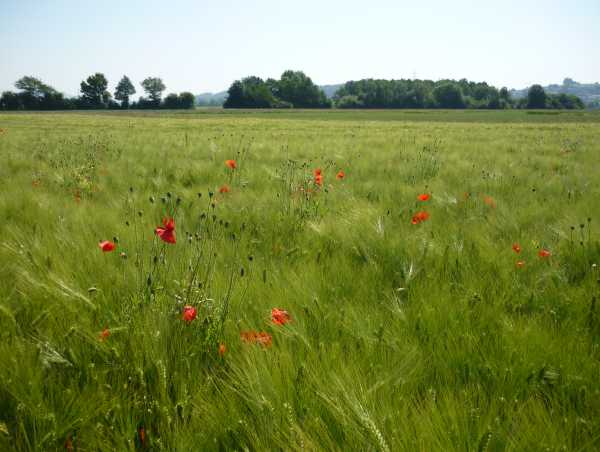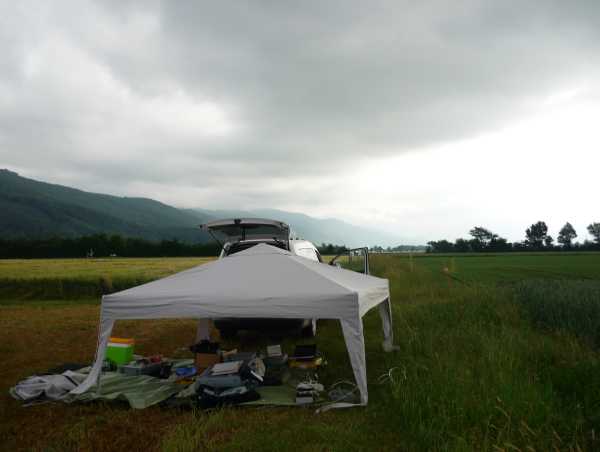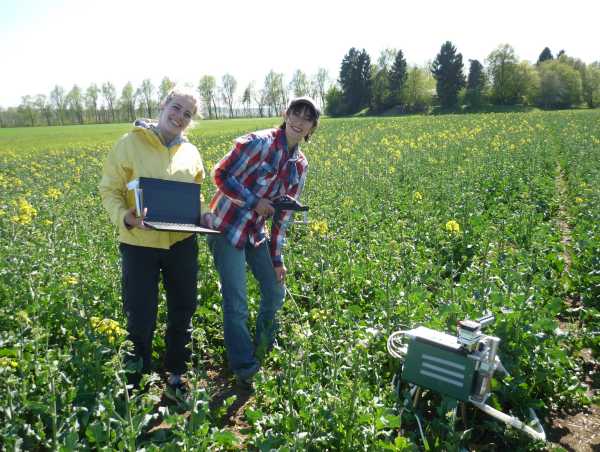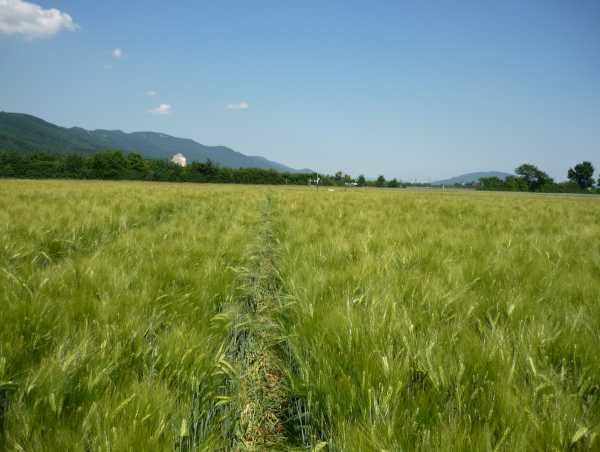DiRad Oensingen
The role of diffuse radiation for a long-term arable crop rotation at Oensingen, Switzerland
Context
Diffuse radiation plays an important role for ecosystem productivity.However, its effect on the cropland C budget is largely unknown. Global crop yield modeled by Mercado et al. (2009) indicate a 25% increase in the net carbon sink due to increased diffuse radiation during the years 1960–1999. However, direct field measurements are scarce. Thus, these model results clearly stress the need for validation with in-depth experimental field measurements as proposed here.
Overall Aim
The overall aim is to improve our understanding of how diffuse radiation affects the CO2 budget as well as the water use efficiency of crops. We will test and develop an integrated method with long-term eddy-covariance flux as well as intensive field campaign measurements at one representative arable site in Switzerland (Oensingen CH-Oen2).
Working Hypothesis
We aim at answering the two major questions: (1) How large are the differences in growth response to diffuse radiation among crop types?, and (2) Why is the observed response to diffuse radiation so variable between crop types?
To answer these questions, we will test three working hypotheses:
- The effect of diffuse radiation on growth and thus net ecosystem productivity depends on crop type. This will be tested at the Oensingen flux site (arable site) using the typical crops in its crop rotation (winter wheat; winter barley; rapeseed; potatoes; peas/beans).
- On days with clear sky but high loads of aerosols, net ecosystem productivity shows the largest enhancement due to the increased fraction of diffuse radiation.
- On an ecosystem scale, the relevance of diffuse light conditions is most pronounced during peak growth when concurrent improvements of water use efficiency (WUE) are expected under diffuse light conditions.
Impressions
Publications
2024
Nelson JA, Walther S, Gans F, Kraft B, Weber U, Novick K, Buchmann N, Migliavacca M, Wohlfahrt G, Šigut L, Ibrom A, Papale D, Göckede M, Duveiller G, Knohl A, Hörtnagl L, Scott RL, Zhang W, Hamdi ZM, Reichstein M, Aranda-Barranco S, Ardö J, Op de Beeck M, Billdesbach D, Bowling D, Bracho R, Brümmer C, Camps-Valls G, Chen S, Cleverly JR, Desai A, Dong G, El-Madany TS, Euskirchen ES, Feigenwinter I, Galvagno M, Gerosa GA, Gielen B, Goslee I, Goslee S, Gough CM, Heinesch B, Ichii K, Jackowicz-Korczynski MA, Klosterhalfen A, Knox S, Kobayashi H, Kohonen KM, Korkiakoski M, Mammarella I, Gharun M, Marzuoli R, Matamala R, Metzger S, Montagnani L, Nicolini G, O'Halloran T, Ourcival JM, Peichl M, Pendall E, Ruiz Reverter B, Roland M, Sabbatini S, Sachs T, Schmidt M, Schwalm CR, Shekhar A, Silberstein R, Silveira ML, Spano D, Tagesson T, Tramontana G, Trotta C, Turco F, Vesala T, Vincke C, Vitale D, Vivoni ER, Wang Y, Woodgate W, Yepez EA, Zhang J, Zona D, Jung M (2024) X-BASE: the first terrestrial carbon and water flux products from an extended data-driven scaling framework, FLUXCOM-X. Biogeosciences 21: 5079-5115, doi: external page 10.5194/bg-21-5079-2024
Nelson JA, ..., Buchmann N, ..., Hörtnagl L, ..., Feigenwinter I, ..., Kohonen KM, ..., Shekhar A, ..., Turco F, ..., Wang Y, et al. (2024) X-BASE: the first terrestrial carbon and water flux products from an extended data-driven scaling framework, FLUXCOM-X. EGUsphere [preprint], doi: external page 10.5194/egusphere-2024-165
2021
Irvin J, …, Hörtnagl L, …, Maier R, …, et al. (2021) Gap-filling eddy covariance methane fluxes: Comparison of machine learning model predictions and uncertainties at FLUXNET-CH4 wetlands. Agricultural and Forest Meteorology 308-309: 108528, doi: external page 10.1016/j.agrformet.2021.108528
2020
Emmel C, D’Odorico P, Revill A, Hörtnagl L, Ammann C, Buchmann N, Eugster W (2020) Canopy photosynthesis of six major arable crops is enhanced under diffuse light due to canopy structure. Global Change Biology 26: 5164-5177, doi: external page 10.1111/gcb.15226
2019
D’Odorico P, Emmel C, Revill A, Liebisch F, Eugster W, Buchmann N (2019) Vertical patterns of photosynthesis and related leaf traits in two contrasting agricultural crops. Functional Plant Biology 46: 213-227 doi: external page 10.1071/FP18061
Revill A, Emmel C, D’Odorico P, Buchmann N, Hörtnagl L, Eugster W (2019) Estimating cropland carbon fluxes: a process-based model evaluation at a Swiss crop-rotation site. Field Crops Research 234: 95-106 doi: external page 10.1016/j.fcr.2019.02.006
Xiao, J, Li, X, He, B, Altaf Arain M, Beringer J, Desai AR, Emmel C, Hollinger DY, Krasnova A, Mammarella I, Noe SM, Serrano Ortiz P, Rey‐Sanchez C, Rocha AV, Varlagin A (2019) Solar‐induced chlorophyll fluorescence exhibits a universal relationship with gross primary productivity across a wide variety of biomes. Global Change Biology 25: e4– e6. external page https://doi.org/10.1111/gcb.14565
2018
Emmel C, Winkler A, Hörtnagl L, Revill A, Ammann C, D’Odorico P, Buchmann N, Eugster W (2018) Integrated management of a Swiss cropland is not sufficient to preserve its soil carbon pool in the long-term. Biogeosciences Discussion doi: external page 10.5194/bg-2018-205
Emmel C, Winkler A, Hörtnagl L, Revill A, Ammann C, D’Odorico P, Buchmann N, Eugster W (2018) Integrated management of a Swiss cropland is not sufficient to preserve its soil carbon pool in the long-term. Biogeosciences 15: 5377-5393 doi: external page 10.5194/bg-15-5377-2018
2016
Revill A, Bloom A A, Williams M (2016) Impacts of reduced model complexity and driver resolution on cropland ecosystem photosynthesis estimates. Field Crops Research 187: 74-86 external page doi: 10.1016/j.fcr.2015.12.006
Vuichard N., Ciais P., Viovy,N., Li L., Ceschia E., Wattenbach M., Bernhofer C., Emmel C., Grünwald T., Jans W., Lobet B., Wu X. (2016). Simulating the net ecosystem CO2 exchange and its components over winter wheat cultivation sites across a large climate gradient in Europe using the ORCHIDEE-STICS generic model. Agriculture, 266: 1-17 doi: external page 10.1016/j.agee.2016.04.017
2015
Damm A, Guanter L, Paul-Limoges E, van der Tol C, Hueni A, Buchmann N, Eugster W, Ammann C, Schaepman ME (2015) Far-red sun-induced chlorophyll fluorescence shows ecosystem-specific relationships to gross primary production: An assessment based on observational and modeling approaches. Remote Sensing Environment 166: 91–105 doi: external page 10.1016/j.rse.2015.06.004
van Dijk AIJM, Gash JH, van Gorsel E, Blanken PD, Cescatti A, Emmel C, Gielen B, Harman I, Kiely G, Merbold L, Montagnani L, Moors E, Roland M, Sottocornola M, Varlagin A, Williams CA, Wohlfahrt G (2015) Rainfall interception and the coupled surface water and energy balance. Agricultural and Forest Meteorology 214-215: 402-415, doi:external page 10.1016/j.agrformet.2015.09.006




